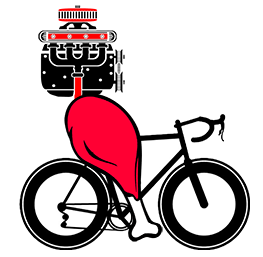Can Cyclists Maintain Gains After Stopping Strength Training?
A recent study explored if competitive cyclists could retain performance and strength improvements achieved from concurrent resistance and endurance training after stopping resistance training. Researchers studied nine well-trained competitive male cyclists over 14 weeks. For the first 8 weeks, the cyclists did periodized resistance training for their legs and core in addition to their normal endurance cycling training. They then stopped resistance training and did endurance cycling training only for the next 6 weeks, leading up to their competitive season, to see if they could maintain their gains.
After the initial 8 weeks, the cyclists improved their leg extension power by 12%, maximal strength of leg extensions (measured as maximal voluntary contraction or MVC) by 15%, and rate of force development (RFD), the ability to quickly generate force, by 17%. They also improved their mean power output over 5 minutes of maximal cycling by 7%. After stopping resistance training for 6 weeks, the cyclists retained their gains in MVC and 5-minute maximal cycling power.
The study shows that for competitive cyclists, stopping resistance training for up to 6 weeks will not reverse increases in maximum leg strength and cycling performance achieved from previous periods of combined strength and endurance training. During the competitive season, cyclists can focus primarily on cycling training to maintain strength and power gained during the off-season from combined training approaches. Cyclists should continue to periodize their training, however, to achieve continued performance improvements from season to season.
In summary, competitive cyclists can gain significant performance and strength benefits from concurrent resistance and endurance training during the off-season. They can then maintain the majority of these gains for at least 6 weeks after stopping targeted resistance training by focusing on cycling training alone leading into and during competition. Continuously varying their training through periodization will help cyclists build upon these gains over multiple seasons.
Practical Implications for the Time Limited Cyclist
If you are limited by time, like most non-professional cyclists are, it might make more sense to spend the time you’d spend strength training (at least your lower body/legs) the last 6 weeks before an A-race to up your available cycling time. Of course, this doesn’t mean randomly increasing your volume or load during that time period. Have a nice periodized plan in place, and make sure to include a proper taper period before the race.
Abstract
Effects of Resistance Training Cessation on Cycling Performance in Well-Trained Cyclists: An Exploratory Study
Effects of resistance training cessation on cycling performance in well-trained cyclists: an exploratory study. J Strength Cond Res 36(3): 796–804, 2022—Supplementary (i.e., concurrent) resistance training can enhance cycling performance among competitive cyclists. However, a lack of knowledge exists about the retention (decay profile) in mechanical muscle function and cycling performance after concurrent resistance and endurance training. The present exploratory intervention study investigated the effect of 6 weeks of resistance training cessation when preceded by 8 weeks of concurrent resistance and endurance training on mechanical muscle function and cycling performance in 9 male well-trained competitive cyclists (V̇o2max = 66 ± 7 ml·min−1·kg−1). Cyclists performed periodized resistance training targeting leg and core muscles for 8 weeks as a supplement to their normal endurance (cycling) training. This was followed by 6 weeks of endurance training only (retention period) leading up to the start of the competitive season. Maximal leg extensor power, isometric leg extensor strength (maximal voluntary contraction [MVC]), rate of force development (RFD), and long-term cycling performance (2-hour submaximal cycling at 55% of Wmax), followed by 5-minute max cycling were evaluated. After 8 weeks of concurrent resistance and endurance training, leg extensor power, MVC, and RFD increased by 12, 15, and 17%, respectively while mean power output (W) during 5-minute max cycling increased by 7% (p < 0.05). Training-induced gains in MVC and 5-minute max cycling power were retained after 6-week cessation of resistance training (p < 0.05). These findings indicate that competitive cyclists can focus on cycling training alone for at least 6 weeks leading up to competition without losing attained gains in maximal muscle strength and cycling performance achieved by preceding periods of concurrent resistance training.
Source: https://journals.lww.com/nsca-jscr/Abstract/2022/03000/Effects_of_Resistance_Training_Cessation_on.27.aspx
J Strength Cond Res 2022 Mar 1;36(3):796-804
Authors: Abstract Bláfoss, R, Rikardo, J, Andersen, AØ, Hvid, LG, Andersen, LL, Jensen, K, Christensen, PM, Kvorning, T, and Aagaard, P.
Listen to the Two Minute Summary

Jordan Fowler has experience as a head swimming coach of the Frisco Swim Team, a TAAF-awarded coach, a track and field distance running consultant for select Texas High School runners, and has competed as a triathlete, road runner, and cyclist. Though he is remarkably slower than he was in his 20s and 30s, he still enjoys endurance sports and sports science studies.
